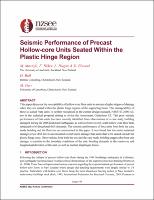| dc.contributor.author | Mostafa, Mohamed | |
| dc.contributor.author | Büker, Frank | |
| dc.contributor.author | Hogan, Lucas | |
| dc.contributor.author | Elwood, Kenneth | |
| dc.contributor.author | Bull, Des | |
| dc.contributor.author | Parr, Michael | |
| dc.date.accessioned | 2023-02-21T01:18:12Z | |
| dc.date.available | 2023-02-21T01:18:12Z | |
| dc.date.issued | 2022-04-27 | |
| dc.identifier.uri | https://repo.nzsee.org.nz/xmlui/handle/nzsee/2480 | |
| dc.description.abstract | This paper discusses the susceptibility of hollow-core floor units to sustain a higher degree of damage when they are seated within the plastic hinge regions of the supporting beam. This damageability of these so-called ‘beta units’ is neither recognised in the current design standard, NZS3101:2006-A3, nor in the technical proposal aiming to revise the Assessment Guidelines C5. This poor seismic performance of beta units has been recently identified from observations of a case study building damaged during the 2016 Kaikōura Earthquake, as well as from two full-scale hollow-core floor tests subjected to bi-directional drift demands. The seismic performance of beta units from both the case study building and the floor test are summarised in this paper. It was found that beta units sustained damage at low drift levels and incurred overall more damage than units that were seated outside the plastic hinge zone. Observations from both the test and the case study building suggest that beta unit damage is sensitive to the boundary conditions of the unit, bending demands in the transverse and longitudinal direction of the unit, as well as inertial diaphragm forces. | |
| dc.language.iso | en | |
| dc.publisher | New Zealand Society for Earthquake Engineering | |
| dc.relation.ispartofseries | 2022;40 | |
| dc.subject | Advancements in structural and geotechnical design and assessment | |
| dc.title | Seismic Performance of Precast Hollow-core Units Seated Within the Plastic Hinge Region | |
| dc.type | Article | |

